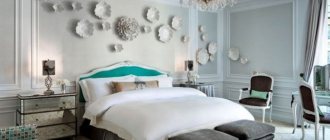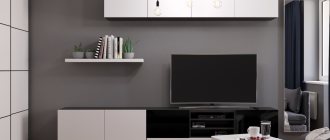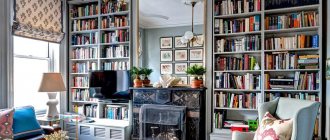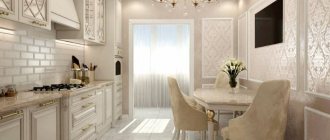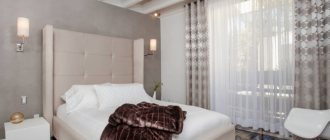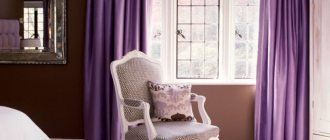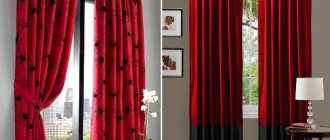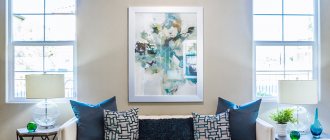Decoration of the dining area
The most daring and interesting design options are not difficult to implement if you know where to start and what to pay attention to. Let's look at the design features of the dining area in kitchens of different sizes.
Small kitchen
The dining area for a small kitchen has its own characteristics. To decorate the dining area, choose small furniture. Miniature options for dining groups are widely available on sale. Arrange the furniture so that the table and chairs do not interfere with free movement in the kitchen, including in the food preparation area.
Light colors expand the space; use them when decorating a small dining area. I want bright colors; rich tones will fit perfectly into the interior as color accents.
Small paintings, posters and other decorative elements in a small room look more profitable than large art objects. It is appropriate to place mirrors on the wall in the dining area. By reflecting light and the surroundings, they make the kitchen wider and brighter.
Spacious kitchen
A large kitchen area is a great opportunity to experiment with the colors and shapes of objects. Stylish furniture of modern or classic design will decorate the interior.
Instead of chairs, you can choose comfortable light armchairs or sofas. A large dining table will allow you to comfortably receive guests, even if the number of guests exceeds your expectations. Additionally, to store tableware and textiles, next to the dining group, you can install a buffet, rack or chest of drawers.
On the walls in the dining area it is appropriate to place bright paintings, a gallery of shelves, or a designer mirror of an intricate shape. Large decorative elements will attract the attention of guests and become an elegant accent. Wallpaper with a contrasting pattern will visually highlight the space of the dining area. The decor in the form of brickwork will add a stylish modern accent to the kitchen interior.
Choosing a color palette and style for the interior design of the kitchen-dining room
The kitchen is the focal point and heart of any home or apartment. And if there is also a dining room in the kitchen, then from the hearth of cooking, the kitchen space becomes a gathering place for the whole family and even receiving guests. The impression of the entire house will depend on how this room is decorated. That is why, when choosing a color palette and stylistic direction that will serve as the basis for the design of the kitchen-dining room, we try to find options that will suit all family members and create a pleasant, comfortable and practical atmosphere for cooking and dining with the whole family.
Interesting and practical color solutions
White will always be the most popular color for decorating kitchen spaces. And the point is not only that the snow-white furnishings give the room freshness and lightness, white decoration and furniture visually expand the space and push the boundaries of the room, but also that, in fact, white surfaces are much easier to care for.
In order to bring brightness to the snow-white idyll of the kitchen space, one colorful element is enough. Use bar stools in a rich shade or a bright kitchen apron design.
The white color of the kitchen cabinet fronts goes well with the shine of stainless steel. If you cover the kitchen backsplash with gray glossy tiles, you can create not only a harmonious and relaxed atmosphere in the kitchen-dining room, but also arrange the room in such a way that it will be cozy and comfortable for all family members and guests of the house.
The total use of white in the room brings an element of coolness. In order to “warm up” the atmosphere of the room a little, you can use the integration of wooden surfaces, be it part of the kitchen furniture, ceiling beams or the design of window and door openings.
When choosing colors for decorating a kitchen-dining room, you can go beyond using white and wood shades, adding bright, rich colors to the furniture. The blue color of the base of the kitchen island has become not just a highlight of the kitchen interior, but also an accent in the orientation of the center of the room.
To create a contrasting interior of the kitchen-dining room, you can’t think of a better combination of black and white in the furnishings and decoration of the room. An absolutely black kitchen set built into a niche with a complex shape and a snow-white island are similar to the use of marble countertops to cover work surfaces. A black wall in a room with a light finish becomes an accent, given that the household appliances for installation were chosen exclusively in black tones.
Another example of a contrasting design of a kitchen area, in which white is used for the facades of kitchen cabinets and a peninsula, and black looks great as the basis of countertops, door and window openings. In this case, the bar counter attached to the peninsula not only acts as a place for organizing short meals, but also serves as a screen, zoning the space into a working kitchen segment and a dining area.
The black and white decoration of the room and the design of the kitchen unit in soft beige wood tones create a truly interesting atmosphere in the spacious kitchen. A non-trivial approach to design and color schemes makes the room memorable, despite the modest execution of the kitchen facades and dining area.
An alternative to using white to decorate kitchen furniture is to use light, pastel colors. Against the background of white walls, even neutral light colors will look expressive, but at the same time maintain the atmosphere of a calm and peaceful kitchen-dining room, in which absolutely everyone is comfortable.
The gray color of the kitchen facades will not be boring if you dilute it with the snow-white design of the ceilings with stucco and fireplace, many glass decorative elements on the chandelier and transparent plastic of the original dining area. Despite the minimalist design of the kitchen set, neutral colors, and the presence of plastic furniture, the kitchen-dining room looks luxurious. Its furnishings are practical but also attractive.
Another example of kitchen furniture in gray tones; even the dining table top has a grayish tint. But at the same time, the room does not look faceless or boring. Thanks to the skillful combination of white and wood shades, the integration of glass, mirror and glossy surfaces, the interior of the kitchen-dining room is interesting and attractive.
A kitchen space with gray cabinet fronts can be bright. It is enough just to add to the deep gray-blue shade of the furniture the brightness of the wooden surfaces and the variegated mosaic decoration of the walls above the working areas of the kitchen-dining room.
The style of the kitchen-dining room - variations on the theme
The design style of your space for cooking and dining will depend on what style was chosen for the overall design concept of the entire apartment or house. For bold and creative decisions, it is possible to deviate from the general motifs in the interior of the home, but it is still better to leave some connection between the rooms of the household, so you can feel comfortable and calm, being in a harmonious and balanced space. If your kitchen-dining room is located in a country house, then a country style for its decoration may be a good option. It is not necessary to install wooden kitchen cabinets with unpainted surfaces; these can be quite traditional facades. But the dining area is better made of wood and you can use either an option with carvings and decoration, or a rustic design in a deliberately simple and even rough form.
To decorate a kitchen in a loft style, a minimalist design of a kitchen set and an island, which, thanks to the built-on countertop, also becomes part of the dining area, is perfect. The stylistic affiliation in this room is “responsible” for the finishing, which contains all the characteristic design features of former industrial premises converted into residential apartments - a spacious room with a high ceiling and large doorways, brickwork and open communications, ceiling beams and ceilings not hidden from view. eyes, and acting as space decor.
A classic kitchen using traditional storage system facades, glass inserts on doors and natural stone countertops is filled with marine motifs if you use an exclusively white and blue color palette. Textiles, dishes and kitchen accessories in blue tones look great on a white background and add a touch of sea freshness and coolness to the atmosphere of the room.
The minimalist style presupposes the most practical and convenient design of space without the use of excessive decor, and sometimes even the absence of decorations as such. Strict and laconic forms of kitchen cabinets, a neutral color palette, the use of natural materials and the installation of furniture, household appliances and work surfaces in accordance with the canons of ergonomics - the resulting interior is not only rational and functional, it is also visually attractive.
Zoning by color
The simplest and most effective method of zoning is to highlight the desired area of the room with a contrasting color. The surface of the floor, walls, or ceiling, which differs in color from the rest of the kitchen design, will visually highlight the place where you eat. The more contrasting the shades are in relation to each other, the more obvious the division of the common territory will be.
Without additional construction of partitions, simply by painting the walls in different colors, we will get two separate rooms: a kitchen and a dining room.
Floors of different textures and colors will indicate where the cooking area ends and the dining area in the kitchen begins.
Colors and shades for the dining area
The place where we eat, talk with loved ones, over a cup of tea, or just relax with a glass of wine should be conducive to such events.
When choosing the colors of the dining area, pay attention to which of them give rise to positive emotions in you, what is closer to you, the intimacy and velvety of deep dark shades or the freshness and lightness of light tones.
All colors are divided into two groups - warm and cold. The effect when using warm and light shades varies.
Cool colors (from purple to yellow-green) refresh the room, emphasize the contours of objects, and calm the psyche. Warm (from yellow to red-violet), they have an encouraging effect, visually warm the kitchen, and soften the atmosphere of the room.
It is necessary to take into account the temperature properties of colors when choosing a specific shade. There are no restrictions on the choice of color, but there are some nuances:
- Light and cool shades visually enlarge the space. Dark and warm ones reduce it.
- A kitchen that rarely sees the sun will be cozier if you use warm shades . On the sunny side, cool tones will visually cool down a room heated by the sun.
- Warm shades increase appetite. If you are on a diet, use cool colors to decorate the dining area and kitchen in general.
Primary colors
Brief characteristics of the primary colors will help you choose the color of the dining area:
- The most pleasant color to contemplate is green. The nature around us is proof of this. A green kitchen has a relaxing effect and helps cope with stress and nervous tension.
- Red color is invigorating and very active, stimulates appetite and increases blood pressure. A red kitchen is suitable for people with an active lifestyle. An alternative to red is a calm pink color. Lightness, energy and warmth will be present in the dining area painted pink.
- Orange color is fruity and joyful, will wake you up in the morning and invigorate you in the evening. Fresh and active orange color, which encourages positive thinking, is suitable for those who need energy replenishment throughout the day.
- Yellow is a sunny, warm and joyful color. It will get rid of a sad mood in cloudy weather and put you in a working mood. Yellow UV is the ability of creative people to work.
- Blue color has a beneficial effect on the human subconscious, instills a sense of security, and perfectly calms the nervous system. Does not promote overeating, reduces appetite.
- Blue is the color of thinkers and intellectuals. In the kitchen it creates a calm environment conducive to long and interesting conversations.
- Brown is an earthy color that is calming and promotes open communication. A kitchen in brown tones is a cozy place for family lunches and dinners with friends.
- Black and white are basic colors, without which the design of any interior is rarely complete. The most contrasting and most noble colors in the palette look different in the interior. The white dining area is an island of cleanliness and tranquility. Black color creates a chamber atmosphere of complete trust and maximum concentration.
Finishing materials
Stone
Today you can often find this material in decoration. Moreover, it can be artificial or natural. And here it is important to use it precisely. That is, apply in certain areas, for example, in some corners. The same photographs can be pasted around the perimeter with such a stone. It will look beautiful. Moreover, today there is a choice of different textures and colors of such material on the market.
Plaster
Another great option. For this, it is best to use textured plaster. It will add volume and will look very harmonious. Additionally, it can be opened with varnish, which will allow it to retain its original appearance longer. Another option is to paint the plaster with special paints that give a pearlescent or metallic tint.
Moreover, the material has all the necessary qualities for use in the kitchen. And in addition, you can combine others with it. For example, with plain wallpaper.
Reproductions of paintings or photographs
Decorative panels or photographs are an excellent option for decorating the walls of the dining area. If you use vertical structures, this will visually increase the height of the ceiling, and horizontal ones, accordingly, will “stretch” the room. This should be taken into account when choosing a form.
The same goes for paintings. If you decide to place on the wall, for example, a reproduction of a famous painting or just a painting by an artist, it is better to choose an image that will stimulate your appetite rather than spoil it. It could be vegetables, fruits, some light landscapes. Portraits and other images are not suitable for the kitchen.
You can also decorate the walls with some handmade elements. This could be dough in the form of something appropriate, clay figurines, fabric works, etc.
Shelves
Why not provide shelves in this area? Of course, they must be placed at a safe distance from the floor so that no one can get injured. It is better to make them narrow, because there will be decorative elements on them: figurines, jars, jugs and other objects. You can take a beautiful transparent jar and beautifully pour, say, cereals, beans or pasta into it. The jar can be closed and wrapped with ribbon.
The option with shelves should be used if the ceilings in the kitchen are of sufficient height, otherwise they will visually make the room wider and the ceilings, accordingly, lower.
Kitchenware
It is not necessary to use shelves to place kitchen utensils. After all, they can be immediately mounted on the wall. However, such elements must be consistent with the overall design of the room.
Self-adhesive or photo wallpaper
Not everyone likes this decision, but it has a right to exist. After all, this approach allows you to obtain large-sized images. And it can be anything: flowers, vegetables, birds, and so on. And again, it should be in harmony with the design of the room.
In addition, such a solution can help effectively zone the space and make the dining area more pleasant and attractive. And some drawings can even visually increase the space. It is worth remembering that catchy images should be in harmony with a plain background.
Zoning options
How else can you separate the space of the dining area in the kitchen? Let's look at some options.
Ordinary partitions are sometimes the most convenient solution to the zoning issue, if the footage of the kitchen space allows. Solid plasterboard or wooden structures with or without glazing, ceiling height or designed in the form of a small bar counter. Transparent and lightweight, made of plastic, rice paper or bamboo. Their general purpose is to delimit the dining area from the rest of the kitchen space, hide the working area of the kitchen unit and create a comfortable place for family dinners and meetings with friends.
Furniture and decor items can also act as a space divider. Pass-through shelving, a large aquarium, or spreading plants will create the necessary barrier between the place where food is prepared and the place where it is eaten.
You can place a carpet on the floor in the dining table area, and a lamp above the table. In the evening, a cozy dining area will be separated from the kitchen space by directional light and a carpet perimeter.
Corner kitchen with a window in a private house or apartment
The optimal solution for a small space is a corner kitchen. This layout will allow you to make maximum functional use of all available space. At the same time, the furniture set and rubble equipment will look compact. A corner kitchen allows you to implement the “triangle rule”, when the hob, refrigerator and sink are located equidistant from each other.
Helpful advice! A corner kitchen with a window is also suitable for a spacious room combined with a living room.
There are several space planning options when designing a corner kitchen with a window. The most popular is the L-shaped arrangement of elements, which are located along the walls, placed perpendicular to each other. The corner can form a work area that continues under the window. Here you can place a sink or hob.
L-shaped arrangement of furniture in the kitchen with a window
A wide tabletop instead of a window sill can serve as a dining table, increasing the functionality of the room. The space under the window opening can be used to store various kitchen utensils.
Another equally popular option is the U-shaped kitchen layout with a window in a private house, which is suitable for any room. However, it is not suitable for narrow rooms whose width does not exceed 2.5 m.
Helpful advice! With a U-shaped layout, you can visually expand the spaces of the room by creating a semblance of a single surface from column cabinets that stand between the window and the door on one side.
For spacious rooms, the best option would be an island layout, where one part of the set is installed along a long wall, and the peninsula is mounted perpendicular to it. This arrangement of furniture zones the room, highlighting the working and dining areas. Different layout options are clearly shown in the photo of the design of corner kitchens with a window.
Corner kitchen with window and cozy dining area
Decoration
Everyone has their own ideas about how the dining area in the kitchen should be decorated. Some prefer free walls and minimalist room design. Others are proponents of abundant decoration and a cozy atmosphere.
To decorate the dining area, you can use wall decorative elements. Paintings, posters, family photos, shelves, mirrors, wall clocks, decorative plates are traditional elements used to decorate a dining room. Combine decorative elements with each other and the kitchen furnishings so that the decorations fit harmoniously into the space.
Advice . Don't use a lot of decoration. One successful painting will look more worthy than many randomly placed decorative plates.
How to decorate your kitchen table every day? In the kitchen, practical things are needed: bamboo rugs, linen or cotton hand napkins, cutlery and dishes, everything must be of high quality, made from wear-resistant materials. Kitchen utensils are constantly washed, napkins are washed, daily care of kitchen utensils is necessary. With such an intense load, low-quality items will quickly become unusable.
Festive decoration is another matter. On special days, the hostess strives to use special decorations to decorate the table. Exquisite textiles with lace elements, beautiful plates and cups with painting or gilding, silverware, multi-tiered candy bowls, crystal, Bohemian glass - these components of comfort have always been used by hospitable hosts to create a festive mood.
Advice . Use elegant tablecloths, napkins and dishes every day. It’s so nice to be in a cozy environment while dining, stopping your gaze at the beautiful and interesting decorative elements placed on the kitchen walls.
